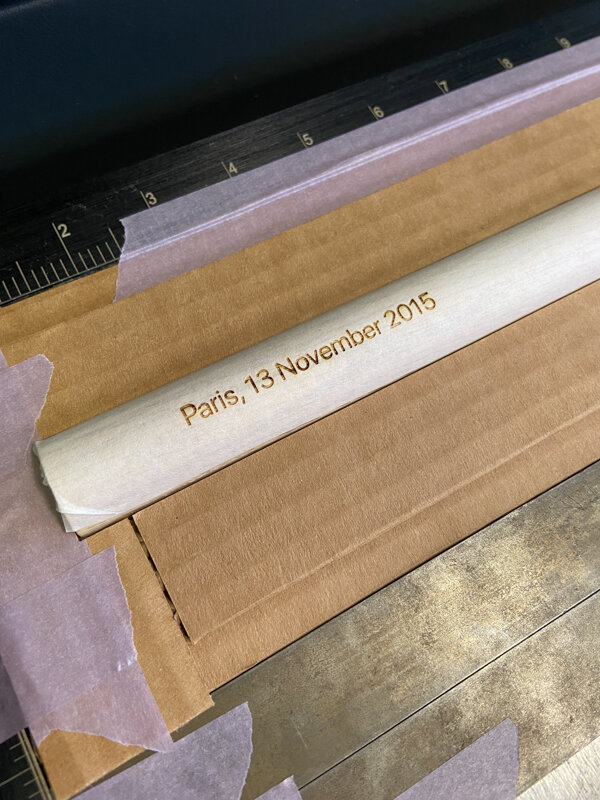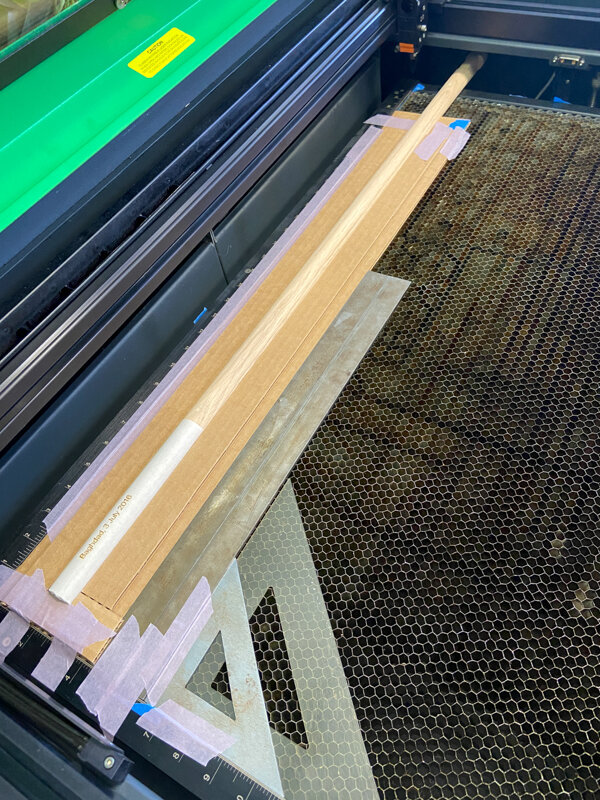Irregular Engraving
Usually, when working on a project I make sure that I have a complete understanding of how the laser cut portion fits into the final piece because trouble can hide in the gaps. Sometimes though, as was the case for laser engraving newspaper holders for Aslı Çavuşoğlu's piece The Morning Herald commissioned by MASS MoCA, I'm not privy to that information making MASS MoCA's reopening in July all the more exciting.
I'm pretty conservative in my movements these days but with MASS MoCA’s large, open galleries I felt safe for a short visit to see how the newspaper holders were used in the final piece. My heart sang when I saw the installation with the graphic quality and rhythmic pattern of the black rectangles skipping across the row of silkscreens.
In this post, I share with you how I worked through the challenges of laser engraving the irregularly shaped newspaper holders.
The Project
Laser engraving newspaper holders for Aslı Çavuşoğlu's The Morning Herald as apart of her With Just the Push of a Voice (al Sol Impulso De La Voz) exhibition in Kissing through a Curtain.
On view at MASS MoCA
July 11, 2020 - October 2021
Curated by Alex Foradas
Laser engraved newspaper holders for Aslı Çavuşoğlu's The Morning Herald
The Challenge
The newspaper holders contained hardware and were irregularly shaped. As a result, they did not lie flat on the laser cutter bed. For uniform engraving, the object must be level!
To address this issue I created a jig with two layers of cardboard. In the bottom layer, a cut-out strip created a recess to accommodate the hardware, and the top layer held the pole in place for perfect registration (below center left).
The poles were also longer than my bed but thankfully there was room to accommodate the extra length (above center right). A low-tack mask was used to protect the wood from vapor residue (above far left).
Aslı Çavuşoğlu, Silk-screened print on newsprint, wood rack, 381×89 cm. Commissioned by MASS MoCA with the support of SAHA.
The Mourning Herald decontextualizes a familiar system of signs—a process of deconstruction that, Çavuşoğlu explains, “spoons[s] things out from the ‘wholeness’ to give us the opportunity to look at so-called intact structures again.” In The Mourning Herald, Çavuşoğlu addresses the visual language of public mourning that has evolved on social media including Facebook: in recent years, individual users have begun to show solidarity with victims of tragedies by changing their profile pictures or backgrounds to solid black. Çavuşoğlu realized that while she might sometimes look at her feed and immediately know what a given friend is mourning, at other times the cause for their grief is unknown. The Mourning Herald makes visible the gaps in understanding and experience that persist in the digital age, despite the immediate access to knowledge and sense of connection that the internet seems to offer.
Çavuşoğlu’s The Mourning Herald also touches on the way in which personal history is constituted online—each print acts as a time capsule of the artist’s Facebook feed after particular tragedies beginning in 2014, attesting to shared moments of grief. In the storied preface to her translation of Jacques Derrida’s On Grammatology, Gayatri Chakravorty Spivak writes that in order to contemplate itself, “the self cannot remain within the ‘simple now-ness of a Living Present,” it must give itself a history, differentiate itself from itself through a backward glance which also makes possible a forward glance.” This moment of the constitution of the (self-considering) self through the construction of a personal history has a parallel in the process through which personal histories—or memories—become shared History.
Excerpt from the exhibition text by Alexandra Foradas
Feeling inspired?
Let’s chat! I’d love to hear more about your new project idea.
Fill out my Project Form.





